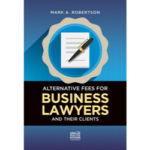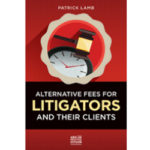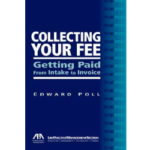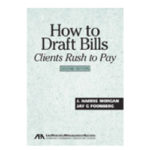The San Francisco Law Library maintains a comprehensive Law Practice Management Collection, with publications that detail all aspects of opening a practice—hanging your shingle, billing, marketing, finances, risk management, technology, and more.
This post introduces the Law Library’s LPM resources that help lawyers create better client billing practices. Stay tuned for future installments that highlight the Law Library’s materials on additional LPM topics.
ALTERNATIVE FEES FOR BUSINESS LAWYERS AND THEIR CLIENTS, by Mark A. Robertson. American Bar Association, Law Practice Division, 2014.
 Transactional matters can be a natural fit for many alternative fee arrangements (AFAs), as long as legal services are properly valued. This book examines the pricing of legal services according to the client’s perception of their value, and sets forth a self-assessment checklist to help you create a billing method for transactional work. With case studies, a detailed analysis of the arguments for and against AFAs, as well as a summary of the pros and cons of each type of AFA, this book covers everything a transactional lawyer needs to make the transition to alternative billing.
Transactional matters can be a natural fit for many alternative fee arrangements (AFAs), as long as legal services are properly valued. This book examines the pricing of legal services according to the client’s perception of their value, and sets forth a self-assessment checklist to help you create a billing method for transactional work. With case studies, a detailed analysis of the arguments for and against AFAs, as well as a summary of the pros and cons of each type of AFA, this book covers everything a transactional lawyer needs to make the transition to alternative billing.
ALTERNATIVE FEES FOR LITIGATORS AND THEIR CLIENTS, by Patrick Lamb. American Bar Association, Law Practice Division, 2014.
 After an explanation of how alternative fee arrangements have thus far been improperly used and have not reached their full potential, author and seasoned litigator Patrick Lamb posits that the future of legal billing is certainly not the hourly rate. Instead, legal billing will morph into a blend of billing practices. Mr. Lamb systematically confronts each of the potential issues of AFAs, and then shows how to use tools such as early case assessment and process mapping to avoid them. This comprehensive exploration of the topic delves into the role of client as judge of value, ethical concerns, pricing and the 50 percent challenge, strategy for implementing AFAs, and more.
After an explanation of how alternative fee arrangements have thus far been improperly used and have not reached their full potential, author and seasoned litigator Patrick Lamb posits that the future of legal billing is certainly not the hourly rate. Instead, legal billing will morph into a blend of billing practices. Mr. Lamb systematically confronts each of the potential issues of AFAs, and then shows how to use tools such as early case assessment and process mapping to avoid them. This comprehensive exploration of the topic delves into the role of client as judge of value, ethical concerns, pricing and the 50 percent challenge, strategy for implementing AFAs, and more.
COLLECTING YOUR FEE: GETTING PAID FROM INTAKE TO INVOICE, by Edward Poll. American Bar Association, Law Practice Management Section, 2003.
 Countless attorneys have relied on the practical advice in this LPM gem over the years. It spans the full arc of the attorney-client experience as it relates to billing, from the initial intake meeting through the collection process. It is filled with sample bills, letters, and forms. The author emphasizes that avoiding billing issues starts with a well-managed law firm, but if you do find yourself needing to pursue overdue accounts, you’ll want to follow the step-by-step guide on how to communicate with clients during this process.
Countless attorneys have relied on the practical advice in this LPM gem over the years. It spans the full arc of the attorney-client experience as it relates to billing, from the initial intake meeting through the collection process. It is filled with sample bills, letters, and forms. The author emphasizes that avoiding billing issues starts with a well-managed law firm, but if you do find yourself needing to pursue overdue accounts, you’ll want to follow the step-by-step guide on how to communicate with clients during this process.
HOW TO DRAFT BILLS CLIENTS RUSH TO PAY, by J. Harris Morgan and Jay G. Foonberg. American Bar Association, Law Practice Management Section, 2nd ed. 2003.
 Many lawyers simply fail to understand the importance of client bills. While lawyers tend to view bills merely as a means for collecting payment for services rendered, clients see them as a record of their lawyer’s effort. Given this disconnect, it is hardly surprising that this book remains an ABA LPM bestseller. It is invaluable for its detailed guidance on what terminology to include and avoid in a bill, sample bills, and, of course, plenty of practical tips from Jay Foonberg himself on how to use the billing process to strengthen the attorney-client relationship.
Many lawyers simply fail to understand the importance of client bills. While lawyers tend to view bills merely as a means for collecting payment for services rendered, clients see them as a record of their lawyer’s effort. Given this disconnect, it is hardly surprising that this book remains an ABA LPM bestseller. It is invaluable for its detailed guidance on what terminology to include and avoid in a bill, sample bills, and, of course, plenty of practical tips from Jay Foonberg himself on how to use the billing process to strengthen the attorney-client relationship.
About the author:
Andrea Woods is a Reference Librarian at the San Francisco Law Library.


